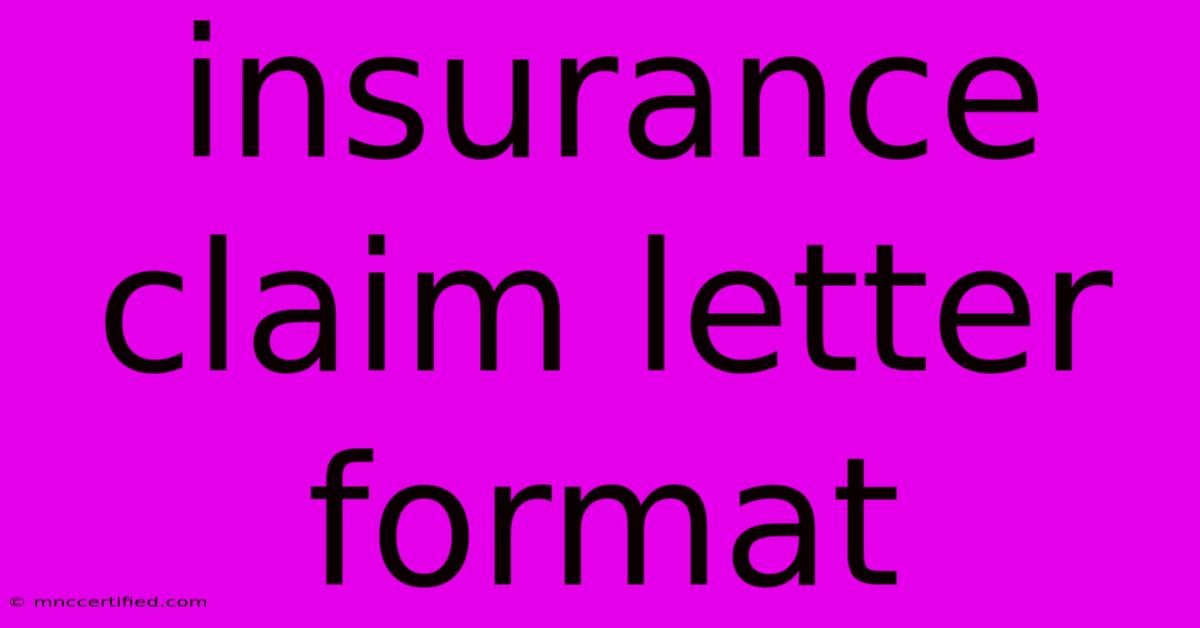Insurance Claim Letter Format

Table of Contents
How to Write a Winning Insurance Claim Letter: A Comprehensive Guide
Submitting an insurance claim can be stressful. A well-written claim letter, however, significantly increases your chances of a smooth and successful process. This guide provides a comprehensive look at the insurance claim letter format, offering tips and examples to help you navigate this crucial step. We'll cover everything from the essential elements to crafting compelling language that gets results.
Understanding the Importance of a Well-Structured Claim Letter
Your insurance claim letter is your first formal communication with your insurance provider regarding a loss or damage. A poorly written or incomplete letter can lead to delays, denials, or even the complete dismissal of your claim. A well-structured and detailed letter, on the other hand, demonstrates professionalism, clarity, and provides the insurer with all the necessary information to process your claim efficiently. This ultimately increases your chances of a swift and fair settlement.
Key Elements of an Effective Insurance Claim Letter
A strong insurance claim letter includes the following key components:
1. Your Contact Information
- Your Full Name: Clearly displayed at the top.
- Your Address: Ensure it's accurate and up-to-date.
- Your Phone Number: Include a reliable number where you can be easily reached.
- Your Email Address: A secondary contact method is always beneficial.
- Your Policy Number: This is crucial for identifying your specific policy.
2. Date of the Letter
- Always include the current date. This helps establish a clear timeline for the claim.
3. Insurance Company Contact Information
- Insurance Company Name: State the full name of your insurer.
- Address: Use the correct address for claims processing. This is often different from the general company address.
- Claim Department (if applicable): Specifying the correct department can speed up processing.
4. Subject Line
- Clearly state the purpose of your letter. For example: "Insurance Claim - Policy Number [Your Policy Number] - [Date of Incident]". This allows the insurer to quickly categorize and prioritize your claim.
5. Detailed Description of the Incident
- Date, Time, and Location: Be precise.
- Narrative of Events: Clearly explain what happened, including all relevant details leading to the loss or damage. Avoid jargon and use plain, concise language.
- Witnesses (if any): Include names and contact information of any witnesses.
6. List of Damages or Losses
- Comprehensive Inventory: Create a detailed list of all damaged or lost items. Include descriptions, quantities, and estimated values (with supporting documentation where possible).
- Photographs or Video: If applicable, include references to any photographic or video evidence supporting your claim.
7. Supporting Documentation
- Policy Documents: Attach a copy of your insurance policy.
- Police Report (if applicable): Include a copy of the police report if the incident involved theft or an accident.
- Repair Estimates: If applicable, attach estimates from qualified repair professionals.
- Receipts or Purchase Records: Provide proof of purchase for any damaged or lost items.
8. Claim Amount
- Clearly State the Total Claimed Amount: This should be a clear sum reflecting the total value of your losses.
- Itemized Breakdown (if applicable): Provide a detailed breakdown of the claim amount if it comprises multiple items.
9. Closing Statement and Signature
- Polite and Professional Tone: Maintain a respectful tone throughout the letter.
- Clear Call to Action: State what you expect from the insurance company (e.g., reimbursement, repair, replacement).
- Your Signature: Sign the letter legibly.
- Typed Name: Type your full name below your signature.
Example of an Insurance Claim Letter Format
[Your Name] [Your Address] [Your Phone Number] [Your Email Address]
[Date]
[Insurance Company Name] [Insurance Company Address] [Claim Department (if applicable)]
Subject: Insurance Claim - Policy Number [Your Policy Number] - [Date of Incident]
Dear [Insurance Adjuster Name or To Whom It May Concern],
This letter is to formally file an insurance claim for damages sustained to my property on [Date of Incident] at [Location of Incident]. [Briefly explain the incident in one sentence].
[Detailed description of the incident, including date, time, location, and a chronological account of events]. [Mention any witnesses and their contact information].
The following items were damaged/lost as a result of this incident:
| Item | Description | Quantity | Estimated Value |
|---|---|---|---|
| [Item 1] | [Description of Item 1] | [Quantity] | [Value] |
| [Item 2] | [Description of Item 2] | [Quantity] | [Value] |
| [Item 3] | [Description of Item 3] | [Quantity] | [Value] |
I have attached copies of [list attached documents, e.g., police report, repair estimates, photographs, receipts]. The total value of the damages is [Total Claimed Amount].
I request your prompt attention to this matter and look forward to hearing from you within [Number] business days regarding the processing of my claim.
Sincerely, [Your Typed Name]
Optimizing Your Claim Letter for Success
Remember that clear communication is key. Proofread carefully before sending! A well-organized, grammatically correct letter reflects positively on you and increases your credibility. Consider using a professional tone and avoiding emotional language. Keep it concise and factual, focusing on the facts of the incident and the resulting damages.
By following this comprehensive guide and using this example as a template, you can craft an effective insurance claim letter that increases your chances of a successful claim resolution. Remember to always keep copies of your letter and all supporting documentation for your records.

Thank you for visiting our website wich cover about Insurance Claim Letter Format. We hope the information provided has been useful to you. Feel free to contact us if you have any questions or need further assistance. See you next time and dont miss to bookmark.
Featured Posts
-
Missing Spotify Wrapped 2024 Find Out Why
Nov 28, 2024
-
Celtic Draw 1 1 Against Brugge
Nov 28, 2024
-
D B Cooper Identity Fbi Update
Nov 28, 2024
-
Heat N Bond Soft Stretch Lite
Nov 28, 2024
-
Ohio Surety Bond Requirements
Nov 28, 2024